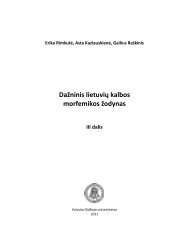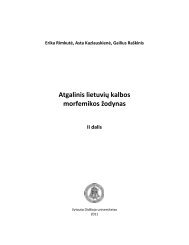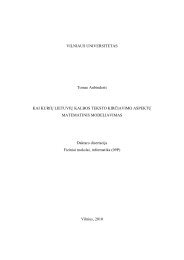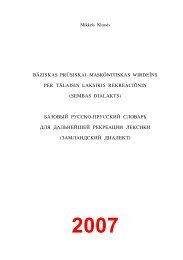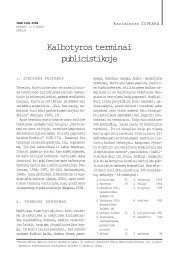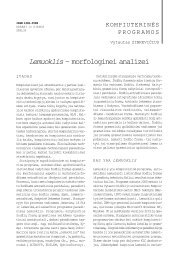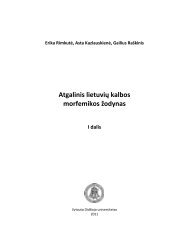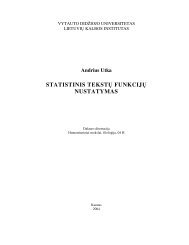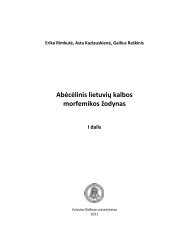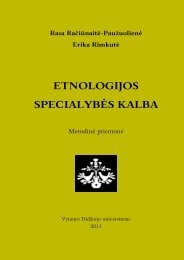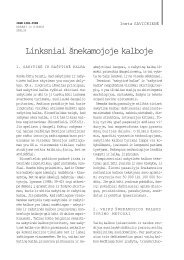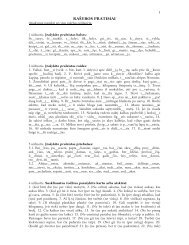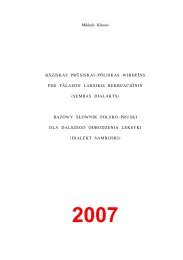HISTORICAL GRAMMAR OF OLD PRUSSIAN
HISTORICAL GRAMMAR OF OLD PRUSSIAN
HISTORICAL GRAMMAR OF OLD PRUSSIAN
Create successful ePaper yourself
Turn your PDF publications into a flip-book with our unique Google optimized e-Paper software.
<strong>HISTORICAL</strong> <strong>GRAMMAR</strong> <strong>OF</strong> <strong>OLD</strong> <strong>PRUSSIAN</strong><br />
I should like to derive the morph Pr. -mans = Pr. -m‹ans from<br />
WBalt. *-m`ns, and I regard the latter to be an unaccented variant of<br />
accented Balt. *-m#ôns < (accented / unaccented) Balt. *-m#ôns. It was its<br />
unaccented variant *-m`ns (> Pr. -mans) which was generalized in West-<br />
Baltic dialects, however in East-Baltic dialects the accented variant was<br />
generalized, i.e. *-m#ôns > EBalt. *-m#ôs > Lith. -mus (= Latv. *-mus) – cf.<br />
what has been said about the origin of acc. pl. masc. Lith.-Latv. -us and<br />
Pr. -ans (* 100).<br />
Similarly, it was a dual inflection (accented / unaccented) Balt. dat.<br />
*-m#ô which manifested in 2 variants as (an accented) Balt. *-m#ô and as<br />
(an unaccented) Balt. *-m` > Pr. -m‹a in its turn. The dual number<br />
vanishing in some later epoch, this Pr. -m‹a was pluralized according to<br />
the pattern dat. pl. *-m‹ans, i.e it was supplemented with final -s as mark<br />
of the plural. In this way dat. pl. Pr. (III) -mas (in pronouns only!) came<br />
into being beside older -mans (I, II, III).<br />
This is the explanation (cf. also Maþiulis Baltistica II 43–52, BS<br />
209 ff., Palmaitis Baltistica XII 161) to which Rosinas BÁM 45 consented<br />
in principle. Nevertheless it is difficult to believe his reconstruction<br />
Balt. dat. pl. *-môs, not *-môns. Cf. also * 166.<br />
`-stems<br />
* 104. Nom. sg. (fem.) The single spelling of this inflection in<br />
(E) is -o (cf. galwo ‘head’, gerto ‘hen’, mergo ‘maiden’). It reflects Pr. (E)<br />
*-¯É = (conventionally) *-` < Pr. *-` (= *-¯É), which turned into Pr. (Cat.)<br />
-û (cf. mergu III, widdewû III ‘widow’) after the labials and gutturals, but<br />
42 It was the quality Pr. *¯É which enabled its transition into *û after the labials and gutturals (*`<br />
could not turn into *û directly). This is confirmed by data of first German record of Samlandian<br />
toponyms in which o (= *¯É) is attested on place of Cat. ` just as in (E), cf. top. Byoten and bi`twei<br />
(III), Bûga III 106. Beside the transition *¯É > û (after L, G), a transition *ç > î is attested in (II, III).<br />
First records of Samlandian toponyms come from the 13th c., but many were recorded later, cf.<br />
Krome 1463, Gerullis ON 73, or Sapoten 1402/ Seppothenn 1494, ibid. 151. This means that *¯É<br />
still had not turmed into ` in 1463 (82 years before I, II), but in 1494 (51 years before I, II) even had<br />
not turned into û after p. A question arises whether in course of 51 years *¯É had time to turn into<br />
û after L, G, but afterwards (*¯É) had time to turn into ` in other positions? In 1545 (II) *ç had<br />
already turned into î, but this means that the transition of *¯É into ` “downwards from above” had<br />
to run almost symultaneously to an opposite transition *ç > î “upwards from below”! Since<br />
therefore the transition *¯É > ` in one of the mostly archaic Baltic languages (which are very<br />
49



